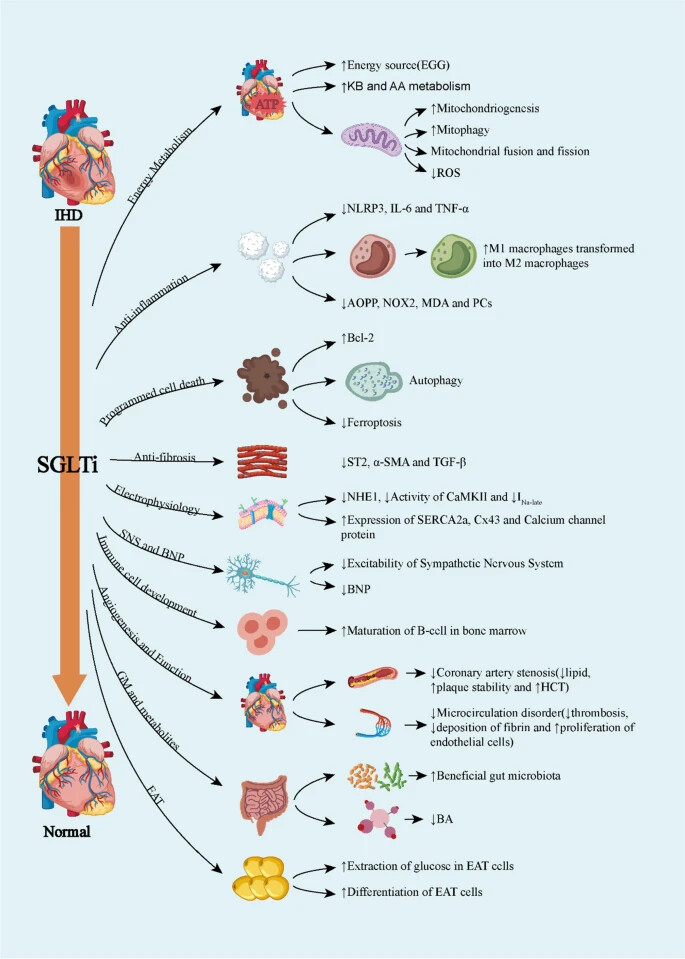Effect of SGLT2 inhibitors on heart failure outcomes and cardiovascular death across the cardiometabolic disease spectrum: a systematic review and meta-analysis 2024
SGLT2 inhibitors reduced cardiovascular death by 14% in patients with heart failure (HR 0·86 [95% CI 0·79–0·93]), 15% in patients with type 2 diabetes (0·85 [0·79–0·91]), 11% in patients with chronic kidney disease (0·89 [0·82–0·96]), and 13% in patients with atherosclerotic cardiovascular disease (0·87 [0·78–0·97]).
SGLT2 inhibitors reduced heart failure events and cardiovascular death in patients with heart failure, type 2 diabetes, chronic kidney disease, and atherosclerotic cardiovascular disease. These effects were consistent across a wide range of subgroups within these populations. This supports the eligibility of a large population with cardiorenal-metabolic diseases for treatment with SGLT2 inhibitors.
Effect of preceding drug therapy on the renal and cardiovascular outcomes of combined sodium-glucose cotransporter-2 inhibitor and glucagon-like peptide-1 receptor agonist treatment in patients with type 2 diabetes and chronic kidney disease 2024
Although the renal composite outcome did not differ between the two groups, the win ratio of the GLP-1RA-first group versus the SGLT2 inhibitor-first group was significant. These results suggest that, in GLP-1RA and SGLT2 inhibitor combination therapy, the addition of an SGLT2 inhibitor to baseline GLP-1RA treatment may lead to more favourable renal outcomes.
Protective Mechanisms of SGLTi in Ischemic Heart Disease 2024

Empagliflozin, a sodium-glucose cotransporter inhibitor enhancing mitochondrial action and cardioprotection in metabolic syndrome 2024
This review focuses on the mitochondrial mechanisms of empagliflozin, which underlie the anti-inflammatory and recover cellular functions in MetS cardiomyocytes, including stabilizing calcium concentration, mediating metabolic reprogramming, maintaining homeostasis of mitochondrial quantity and quality, stable mitochondrial DNA copy number, and repairing damaged mitochondrial DNA.
Safety of Empagliflozin: An Individual Participant-Level Data Meta-Analysis from Four Large Trials 2024
Total trial medication exposure was 19,727 patient-years for patients who received empagliflozin (n = 10,472) and 19,447 patient-years for placebo (n = 10,461). The percentages of patients with serious AEs, fatal AEs, and AEs leading to discontinuation were similar for both groups. The incidences of serious urinary tract infection and serious pyelonephritis or urosepsis were similar for both groups but higher for women taking empagliflozin versus placebo. Serious genital infections were not increased with empagliflozin versus placebo. There was a slight increase in ketoacidosis and serious volume depletion in patients who received empagliflozin versus placebo. The occurrence of serious acute kidney injury was lower with empagliflozin versus placebo. Empagliflozin was not associated with an increased incidence of severe hypoglycemia, bone fractures, or lower limb amputations. Empagliflozin is therefore considered safe in people without diabetes, the elderly, patients with very low estimated glomerular filtration rate, low body mass index, and HF. Safety is unaltered by blood pressure, concomitant medication for hypertension, HF, and immunosuppression.